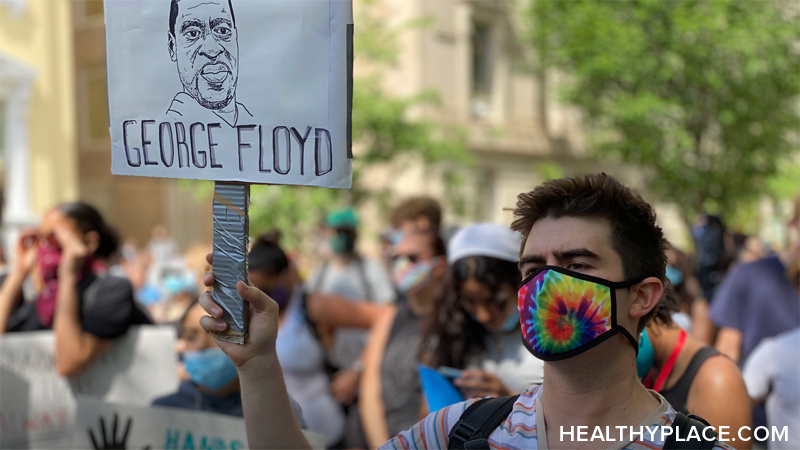Descent into darkness
Descent into darkness
By Louise Kiernan
Chicago Tribune
February 16, 2003
First of two parts
The mothers are searching for their daughters.
 They are always searching for their daughters, even though their daughters have been dead for more than a year now.
They are always searching for their daughters, even though their daughters have been dead for more than a year now.
At a march on the lakefront, the two women share a hug and a murmured joke, heads close, hands woven together. On the telephone, they whisper so they won't wake napping grandchildren.
In a meeting of mental health experts at a dingy medical library, they trade a quick wave across the room. They explain who they are.
"I'm Carol Blocker and I lost my daughter through postpartum psychosis."
"I'm Joan Mudd and I lost my daughter to postpartum depression four weeks after Carol's daughter, Melanie, took her life."
Carol Blocker reaches for a discarded napkin to wipe her eyes. Joan Mudd pushes past the crack in her voice.
The two mothers aren't friends so much as allies. They want the same answers. They want to know why their daughters, after giving birth to the children they desperately wanted and desperately wanted to love, became mentally ill and took their own lives. They want to make sure that no one else's daughter dies.
In obvious ways, they are different. Carol is black, petite and precise, with hands that reach out unconsciously to smooth wrinkles and brush away crumbs. Joan is white, tall and blond, with a raucous laugh and the frame of the model she once was. But they are also alike, in their anger and determination and the pain in their eyes sharp as hooks.
Even their apartments are similar, airy, high-rise perches cluttered with evidence they have gathered in their struggle to understand: videotapes, pamphlets, articles from medical journals. A worn handout on how to deal with someone who is depressed, a laminated eulogy, a plastic bag with 12 bottles of pills and, everywhere, photographs.
Look at Jennifer Mudd Houghtaling in her wedding dress, her gloved arms flung wide in joy. Look at Melanie Stokes, her pregnant belly bursting bare from beneath a red scarf wrapped around her chest.
Look at Melanie at 20, a homecoming queen waving from a car, flowers tucked into the crook of her arm. Look at Jennifer at 12, sitting on a raft in a lake, a sheet of dark hair hanging to her shoulders, arms wrapped tight around her knees.
Look, because you can't help but look, for a portent of what will happen. Look for a shadow, for the sadness lurking at the corner of a mouth.
Look for some hint that Jennifer Mudd Houghtaling, less than three months after delivering her first child, will stand in front of an elevated train, hands raised above her head and wait for it to kill her.
Look for the sign that Melanie Stokes will write six suicide notes, including one to a hotel clerk and one to God but not one to her infant daughter, line them up neatly on a nightstand and drop from a 12th-floor window.
There is no hint. There is no sign.
The college student waves. The bouquet blooms.
The girl smiles. The sun shines.
Rare cluster of tragedy
Melanie Stokes was the first to die, on June 11, 2001.
Over the next five weeks, three more new mothers in Chicago followed her.
On June 18, the day before her daughter's first birthday, Amy Garvey went missing from her home in Algonquin. Her body was found floating in Lake Michigan two days later.
On July 7, Jennifer Mudd Houghtaling slipped out of her mother's Gold Coast apartment and walked to the "L" station to kill herself.
Ariceli Erivas Sandoval disappeared on July 17, five days after she gave birth to quadruplets, and drowned herself in Lake Michigan. A blue sign reading "It's a Boy!" was found on the floor of her car.
This cluster of apparent suicides was rare, the flash of attention it drew even rarer. What people know about mental illness among new mothers they know mostly from women who kill their children, like Andrea Yates, who drowned her five children in Houston nine days after Melanie Stokes committed suicide. In these cases, the horror of the deed often clouds the horror of the illness.
Most women who suffer postpartum mood disorders do not kill their children or themselves. They just suffer. And, with time and treatment, they get better.
Postpartum depression, some experts say, is the most common yet most frequently undiagnosed complication of pregnancy, affecting somewhere from 10 to 20 percent of women who give birth, or almost half a million women every year.
Postpartum psychosis, which usually involves hallucinations and delusions, is a much rarer condition but so severe that the woman is at risk of hurting herself and her baby.
The deaths of Melanie Stokes and Jennifer Mudd Houghtaling may have been unusual but they convey larger truths about postpartum mood disorders. These illnesses are often diagnosed late or not at all. Treatment, if it's available, may be a matter of guesswork. People can get sick and sicker with the speed and unpredictability of an avalanche.
The volatility of these postpartum disorders is one way they differ from mental illnesses that strike at other times of life, some experts believe. Another is the context in which they occur, during the period of extraordinary physical, mental and emotional stress involved in caring for a newborn.
No one keeps track of how many new mothers in the United States kill themselves. But suicide may be more common than people believe. When officials in Great Britain examined the records of all women who died, from 1997 to 1, within a year of giving birth, they found that suicide was the leading cause of death, accounting for an estimated 25 percent of the 303 deaths related to childbearing. Almost all the women died violently.
"This is the real shock," says Margaret Oates, a perinatal psychiatrist involved in the study. "It's an indication of the profound level of mental illness. This was not a cry for help. This was an intention to die."
Melanie Stokes and Jennifer Mudd Houghtaling took different paths toward death. But, as they deteriorated, their families felt the same confusion about what was happening. They experienced the same frustration with medical care that, at times, seemed inadequate and uncaring. Ultimately, they felt the same despair.
Lifetime of anticipation
Sommer Skyy Stokes was delivered to her mother on Feb. 23, 2001, after 19 hours of labor and almost a lifetime of anticipation.
Melanie didn't give birth until she was 40 but she had named her daughter before she was 14, for her favorite season.
Even as a freshman in high school, when the other girls talked about the careers they dreamed of, Melanie unabashedly declared she wanted to become a wife and mother.
After Melanie was admitted to Spelman College in Atlanta, she decided that, someday, Sommer would go to Spelman, too. Once, out shopping, she saw an antique pink feeding bowl and bought it for her daughter-to-be.
It seemed for a painfully long time, though, that Melanie would be granted every wish in life except the one she wanted most of all.
The daughter of an insurance agent and a teacher, Melanie grew up within an extended family that nurtured ideals of education, equality and achievement. At 3, Melanie went with her grandmother to Washington, D.C., to hear Dr. Martin Luther King Jr. speak. She and her younger brother, Eric, graduated from private schools in Chicago to attend two of the nation's most prestigious historically black colleges.
She was so beautiful that one friend used to joke it took a strong constitution to stand next to her. Her sense of self-possession was such that she once delivered a plate of home-baked cookies to a neighborhood drug dealer with the request that he please cut down on the trade in front of her home.
Every aspect of her life was polished into perfection. Pajamas pressed and starched at the dry cleaners. Dinner, even takeout, eaten on the good china. No event went unmarked. When Melanie planted a tree in her yard, she hosted a party, complete with a poetry reading.
Melanie's first marriage broke up after four years, in part because the couple couldn't have children, friends and family say. Not long after, she met a urology resident at a conference sponsored by the pharmaceutical company where she worked as a district sales manager.
Sam Stokes saw Melanie across the room and decided he was looking at the woman who would become his wife. They were married within the year, in a small ceremony on Thanksgiving Day, at one of Melanie's favorite places, Garfield Park Conservatory.
For almost three years, Melanie and Sam tried to have children. Melanie took fertility drugs but nothing happened.
As time wore on, she became more reconciled to the idea that she might not be able to have a child. She decided she would be content in her role as "Mimi" to Andy, Sam's son by a previous relationship, and perhaps adopt.
A few days after she decided to give up her attempts to conceive, Melanie realized she might be pregnant. She bought a home-pregnancy test at a Wal-Mart in Springfield, where she was traveling for work. She was so excited that she performed the test in the store's bathroom.
Melanie approached her pregnancy in the same thoughtful and methodical manner she did everything else. She made lists of the activities she hoped to share with her child someday (Tuesday would be shopping day). At her baby shower, Melanie insisted that no one buy her gifts. All she wanted from her friends was for each of them to write her a piece of parenting advice.
Although she had always dreamed of having a daughter, Melanie didn't find out the sex of her baby, so it was a surprise when after a long and hard labor, her husband and then her mother called out, "It's a girl!" At that moment, the culmination of everything she had wished for, Melanie was too worn out to manage much more than a weak smile.
Two days later, she and Sam brought Sommer home to their red-brick townhouse near the lakefront on the South Side. They bought it because Melanie's mother, who is divorced from her father, lived in a condominium just across 32nd Street. The couple planned to move soon to Georgia, where Sam was going to start a urology practice with an old friend, but wanted to keep the townhouse for visits.
Melanie had been home about a week when her best friend from college, Dana Reed Wise, called from Indiana to see how she was doing. Melanie, usually effervescent, spoke in a monotone.
"I'm fine," Wise remembers her saying. "I'm just tired."
Then, in a voice so quiet it was almost a whisper, she said, "I don't think I like this."
"You don't like what?" Dana asked her.
"Being a mother."
Chronicle of despair
In the brown kraft paper journal her father gave her, Melanie tried to explain what happened.
"One day I wake up pacing then increasingly tired, then disturbed enough to go outside then I feel the thump in my head," she wrote in small, tight handwriting across the bottom of a page.
"My whole life becoming altered."
That was how it must have felt to her, like a blow, like something that jumped out at her from the dark. But, to almost everyone else, the encroachment of her mental illness was so stealthy that they did not see the shadow creeping over Melanie until she was almost engulfed.
She kept changing Sommer's formula, insisting each one made her cry too much. When a friend asked to see the nursery, Melanie refused, saying it wasn't neat enough. She stopped writing thank-you notes.
Sometimes, when Sam was paged at 2 or 3 a.m., he awoke to find Melanie already up, sitting on the edge of the bed, even though Sommer was asleep. Once, when the baby fell off the sofa where she had been sleeping and began screaming, Sam ran to comfort her, while Melanie looked on, seemingly unconcerned.
Sam thought Melanie was just having a hard time adjusting to motherhood. Her aunts Vera Anderson and Grace Alexander, who were helping her with Sommer, decided she had a touch of the "baby blues."
At first, it can be hard to distinguish the normal stress of new motherhood from a mild case of the blues or a more serious mood disorder.
People often don't know what to expect from parenthood. They aren't sure if what they feel is normal. Some of the classic symptoms of depression--lack of sleep, appetite or sex drive--are common experiences for someone trying to care for a newborn.
If women do feel unhappy or anxious they may be reluctant to tell anyone. Everyone is telling them that motherhood should be the most joyful experience of their lives. They worry that someone will try to take away their baby.
During the first week or so after delivery, many women experience the baby blues and find they are unusually weepy, irritable and sensitive. The blues usually resolve themselves within a few weeks.
Carol suspected something wasn't quite right with her daughter but she didn't know what. She urged her to see a doctor but Melanie insisted on waiting for her six-week checkup with her obstetrician.
There wasn't much Carol could do. Women in the United States are not routinely screened for symptoms of a postpartum mood disorder as they are, for example, in Great Britain.
They usually don't see their obstetricians for six weeks after they give birth, and may not see them again for a year after that, a gap that Richard Silver, chairman of the Obstetrics and Gynecology Department at Evanston Northwestern Hospital, calls "an absolute void in care."
The doctor women do see during the early months of motherhood--their child's pediatrician--often is not trained to recognize symptoms. And many women are afraid to confide in their child's doctor.
By the beginning of April, Carol became worried enough about Melanie that she didn't like to leave her alone. So she brought her daughter and five-week-old granddaughter with her the night that report cards were distributed at Healy Elementary School, where she taught 4th grade.
There they sat, in Carol's classroom, and Melanie just couldn't seem to hold the baby right.
She rocked her. She switched her from side to side. She put her down in the Moses basket, and when she started crying, she picked her back up. She put her back down. Melanie's eyes were vacant.
After that, she started to slip fast. Melanie told her mother the neighbors kept their blinds closed because they knew she was a bad mother and didn't want to look at her. She decided that Sommer hated her.
By the time Melanie went to see her obstetrician on April 6, her mother and aunts were caring for Sommer. Finally, at Melanie's checkup, with her mother by her side, the doctor asked her how she felt.
"Hopeless," she answered.
'No good to myself'
Later that afternoon, Melanie stood with her husband in their immaculate townhouse, which she had decorated in her confident, colorful style--a trio of giant tin giraffes in the bedroom and silk curtains the shade of saffron in the kitchen.
Her voice was as flat as her surroundings were vibrant.
She needed Sam to drive her to the emergency room, she said, because her obstetrician thought she should be evaluated by a psychiatrist for postpartum depression.
Sam didn't know what to say.
His wife was beautiful. She was smart. She had a husband who loved her. A successful career. A comfortable home. Enough money to buy almost anything she wanted to buy and go almost anywhere she wanted to go. On top of everything else, she had the daughter she had dreamed of since childhood.
How could she be depressed?
Sam didn't understand what was happening. As he and his wife left for the hospital in silence, they headed into a world that would offer Melanie and the people who loved her little in the way of answers.
The causes of postpartum mood disorders remain unknown, but recently, some experts have come to believe that the dramatic physiological changes that occur with birth and its aftermath may play a role in their onset.
During pregnancy, a woman's estrogen and progesterone levels skyrocket, then plummet to pre-pregnancy levels within a few days of giving birth. Other hormones, including oxytocin, which is known to trigger maternal behavior in some mammals, and cortisol, which is released in times of stress, also change dramatically during pregnancy and afterward.
Hormones act upon the brain in ways that can influence mood and behavior. Some researchers think that in women who may already be vulnerable for some reason--because of a prior bout of mental illness, for example, or stressful life events--these biological shifts may trigger psychiatric illness.
Melanie came back home from the emergency room at Michael Reese Hospital that evening. The emergency room doctor didn't think she was sick enough to admit, hospital records show, and referred her to a psychiatrist.
Whatever strength Melanie had mustered to maintain control evaporated. Over the weekend, she became more agitated and upset. She couldn't stop pacing. Early Sunday morning, Sam awoke to find Melanie gone. He went outside and found her walking back from the lakefront in the dark.
Later that morning, they returned to the emergency room at Michael Reese and Melanie was admitted to the psychiatric unit.
By the time Melanie got help, she was so sick she needed to be hospitalized. Most women with postpartum mood disorders can be treated as outpatients, with a combination of medication, therapy and social support.
Drugs work in about 60 to 70 percent of cases, but they can be tricky to administer. Finding the right mix of medications and doses can be a matter of trial and error. Some medications produce serious side effects; most don't take full effect for weeks.
At the hospital, Melanie told a social worker that she had become increasingly anxious about parenting, her medical records show. She thought that she should do that as well as she had done everything else in her life. She couldn't tell anyone how desperate she felt. Finally, she said, she couldn't function anymore.
"I can't care for myself or my child feeling like this," she said. At the hospital, doctors placed Melanie on antidepressant and antipsychotic drugs, as well as a nutritional supplement, because she wasn't eating.
No one used the word "psychosis," her family says. But depression didn't seem to describe the distant, agitated woman who sat in the hospital room, stony-faced and fiddling with her hair.
"How can I explain to anybody how something has literally come inside my body," Melanie wrote in her journal. "(T)ook away my tears, joy, ability to eat, drive, function at work, take care of my family. ... I'm just a useless piece of rotting flesh. No good to anyone. No good to myself."
From her 10th-floor condominium, Carol Blocker could see Melanie's hospital room.
Every night, she stood at the window with a flashlight. She flicked it on and off so her daughter would know she was there.
Groping for an explanation
In a matter of seven weeks, Melanie was admitted three times to the psychiatric units of three different hospitals. Each stay followed the same pattern.
She deteriorated, then, as her discharge date approached, she seemed to get better. When she went home, whatever progress she had made disappeared.
Her family ricocheted from hope to despair to frustration. Carol says she once chased a doctor down a hallway, trying to get some sort of explanation for what was happening to her daughter. Melanie's aunts assured themselves after each hospitalization that this time she seemed better. Sam told himself to be patient.
After she was discharged from Michael Reese following a five-day stay, Melanie stopped eating again. At meals, she daintily wiped her mouth with a napkin after each bite. Afterward, her aunt Grace would find the crumpled napkins full of food in the trash.
When Carol took her back to a hospital, this time to the University of Illinois at Chicago Medical Center, Melanie told the doctors she hadn't eaten for a week.
She wanted to eat, she said, but she couldn't swallow.
She was admitted overnight for dehydration and released the next morning for a scheduled appointment with a psychiatrist. The psychiatrist changed her medication and decided to start her on electroconvulsive therapy (ECT), more commonly known as shock treatment.
Once considered violent and inhumane, ECT has quietly regained popularity among many psychiatrists as a safe and effective treatment for severe depression and psychosis. In ECT, electricity is used to cause a short, controlled seizure in the brain while the patient sleeps under general anesthesia.
No one knows exactly why these seizures may relieve the symptoms of mental illness but they often do. Typically, someone will undergo five to 12 sessions of ECT over two or three weeks.
From the start, Melanie hated the treatments. She said it felt as though her brain were on fire. When she came home from the first ECT, she crawled into bed, exhausted.
Her aunts Vera and Grace crept upstairs to check on her. She was curled up in a ball, so small and thin she barely made a lump beneath the blankets.
Then, after her second treatment, Melanie came back to herself.
She started talking and laughing. In the recovery room, she drank half a dozen glasses of orange juice and ate packets of cookies and crackers from the vending machine, consuming more in three hours, Sam thought, than she probably had in the previous three weeks.
Because ECT can affect short-term memory, Melanie didn't know where she was or what had happened to her.
"I have a baby?" she kept asking Sam. "I have a baby?"
After three hours or so, she slipped back into her silence. There was little improvement after her third treatment and when it came time for her fourth session, she refused.
"It's killing me," she told her husband.
By Mother's Day, she was back on a psychiatric ward, at UIC.
Before she was a mother herself, Melanie had once celebrated Mother's Day by buying flowerpots for the children in her neighborhood and helping them decorate the containers for their mothers.
This time, she sat on her hospital bed, blank-faced, when Carol brought Sommer to see her. In the nine days she had been hospitalized, she had never asked her mother about Sommer and now she had to be told to take her into her arms.
Melanie had resumed the ECT treatments and started another combination of medications. But her weight continued to drop. At 5 feet 6 inches tall, she now weighed 100 pounds. Whenever anyone asked her how she felt, she said she thought she would never get better.
She thought God was punishing her and, in her journal, made a list of her sins in an attempt to figure out why. She had lied once as a child about being kicked in the head. She had thrown a dissected frog at someone in high school.
"Hurt people who were trying to be kind," she wrote.
Every night, Melanie's father, Walter Blocker, sat with her in her room. He massaged her feet, whispering to her as if she were still an infant.
You'll get better, he told her. This will end.
You'll get better. It's all right.
Trying to be a mom
Melanie spent 19 days at the University of Illinois at Chicago Medical Center. The day after she was released, she asked her neighbor for a gun.
It's for Sam, she said. He likes to hunt and I'm thinking about buying him a gun for his birthday. The neighbor demurred, then called Sam at work. Sam told him that he had never gone hunting a day in his life. Not long after that, she visited her aunt Grace, who lives on the 22nd floor of a high-rise, and sat for hours, looking out her windows. After her mother learned that she had been wandering near the lake again, she told Melanie that the doctors were concerned about her blood pressure and took her back to the hospital.
UIC was full and sent her to Lutheran General Hospital in Park Ridge. When she arrived on May 27, she had already been through four different combinations of anti-psychotic, anti-anxiety and anti-depressant drugs, as well as the electroconvulsive therapy.
Twice, Melanie had stopped the ECT treatment and she refused to start up again at Lutheran General. At the hospital, she was suspected of spitting out her medication at least once.
She wanted to get out and, her mother thought, was trying to fool people to do it. At one point, her records show, she described her mood as "calm," even though she sat with her hands clenched. When she was asked what she needed to get back to her old self, she answered, "Organization."
To that end, she drew up a timetable of her plans to integrate herself into Sommer's life. When she was released after five days, she took it with her.
Almost every day, Melanie visited her daughter, who was staying with one of her aunts, Joyce Oates. Melanie always plucked at Sommer's clothes or fussed with her hair, tics that never quite masked the fact that she rarely held or cuddled her.
Her family could see that her smiles were forced and her arms stiff. Sometimes, the only physical attention she could give Sommer was to clip her fingernails.
If Melanie ever had thoughts of hurting her daughter, she didn't tell anyone, but her aunt Joyce was concerned enough that she didn't leave Melanie alone with the baby.
On June 6, five days after Melanie came home from the hospital, she told Joyce she wanted to learn her daughter's bedtime routine. She watched as her aunt fed and bathed Sommer.
Joyce lay the baby's nightgown on the bed and asked Melanie to put it on her. Melanie picked it up and stared at it. Then, she put the nightgown back on the bed.
"I can't do it," Joyce remembers her saying.
She turned around and went back to the living room.
It was the last time her daughter saw her.
Goodbyes to all
Melanie tried to say goodbye.
Early the next morning, she called her mother and told her she had been a good parent. Her father got a telephone call, too, while he was shaving. She said she loved him.
For Sam, there was a note tucked under a corner of a photo album she placed on the kitchen table.
He had walked in from a Thursday staff meeting at Cook County Hospital, expecting to pick up Melanie. They had planned a day out together. It wasn't until he had made half a dozen telephone calls and two trips to the lakefront to look for her that he saw the note.
"Sam, I adore you, Sommer and Andy, Mel."
Puzzlement dawned into panic. Her family contacted police and with her friends scattered around the city to search her favorite spots: the Osaka Garden in Jackson Park, Bloomingdale's, the Garfield Park Conservatory.
A neighbor later told the family she saw Melanie getting into a cab. After that, she vanished, a thin woman in an orange peacoat, sweat shirt and jeans.
Melanie's last stop
The woman who arrived at the Days Inn across from Lincoln Park late Saturday night was neatly dressed and clean, polite almost to a fault.
Her bag had been lost or stolen on the train, she said, and she didn't have any identification on her. But she did have cash. Could she book a room?
Tim Anderson, the front desk supervisor, was sympathetic but skeptical. He told her he couldn't allow someone to pay cash without photo identification. But she was welcome to wait there until she heard from the lost-and-found.
So, Melanie spent most of Sunday in the hotel's cramped lobby, little more than an alcove with two armchairs and a sliding-glass door. Occasionally, she chatted with Anderson. She asked him where she could get something to eat and he directed her to a coffee shop around the corner. Later, she bought a chicken quesadilla from the restaurant next door and he let her eat in the break room.
From time to time, she left the hotel. At some point, she went to the Dominick's at Fullerton and Sheffield Avenues, where an employee in the cafe later would find a blank card with a photograph of Melanie and Sam enclosed.
Melanie's family had turned to the local newspapers and television stations asking for help in finding her. Her photograph was in the Sunday newspapers in the convenience store across the hotel lobby. No one recognized her.
She didn't strike Anderson as someone who was hiding or homeless, but something about her just didn't seem right.
Before Anderson left for the day, he says, he told his replacement not to allow her to check in unless she produced some identification. But just after 5:30 p.m., her bill shows, Melanie paid $113.76 for a room, in cash. She checked in under the name Mary Hall.
She was given Room 1206, on the top floor of the hotel. From her window, she could see the Lincoln Park Zoo, which was her father's favorite place to spend his birthday, walking with Melanie.
Just before 6 the next morning, a cyclist riding by the hotel saw a woman perched on a window ledge and ran inside to tell the clerk.
Within minutes, firefighters were in Melanie's room, trying to talk her back inside. She sat on the other side of a window, her back straight and pressed against the glass.
Paramedic Deborah Alvarez tried to reassure her. This woman, she thought, looks as frightened as a child. Melanie answered but the glass blocked her voice. Alvarez never heard what she said.
After about 20 minutes, a firefighter approached the window. Melanie turned a little, as if she were going to try to pull herself up. Then, she turned back, put her hands at her side and dropped from the ledge.
Gasps and screams rose from the small crowd that had gathered across the street. One of Melanie's shoes fell off and bumped against the building.
Alvarez raced for the elevator, hoping against hope. When she ran outside, she saw that Melanie's body had already been covered.
In her room, the bed was made. On the radiator cover was a copy of the Chicago Sun-Times. The front-page headline was about her.
On a night stand next to the digital clock sat a neat stack of notes, written on hotel stationery, with a pen laid perfectly straight in the middle.
Melanie wrote a note to her parents. It said, in part, "Please let Sommer know how much I loved her during the pregnancy."
She wrote a note to her husband, telling him to continue with their plans to move to Georgia and thanking him for loving her in "such a generous, sweet way."
She wrote a note to Tim Anderson, the employee who let her sit in the lobby.
"I am so sorry to have used your kindness in this way," it said. "You really are a fabulous clerk--very good at what you do. Tell your boss this was not your fault."
She wrote a note to herself.
"Everyone going along with normal happy lives. I wish I was normal again."
In her apartment on Chicago's Gold Coast, Joan Mudd read about Melanie's death in the newspaper. She tore out the article and tucked it into a drawer. She didn't want her daughter Jennifer to see it.
----------
WHERE TO FIND HELP
Postpartum Support International, Illinois chapter: (847) 205-4455, www.postpartum.net
Depression After Delivery: (800) 944-4773, www.depressionafterdelivery.com
Jennifer Mudd Houghtaling Intervention Program for Postpartum Depression at Evanston Northwestern Healthcare, 24-hour toll-free hot line: (866) ENH-MOMS
Pregnancy and Postpartum Mood & Anxiety Disorder Program at Alexian Brothers Hospital Network, Elk Grove Village: (847) 981-3594 or (847) 956-5142 for Spanish speakers Perinatal Mental Health Program, Advocate Good Samaritan Hospital, Downers Grove: (630) 275-4436
next: Forced ECT
~ all Shocked! ECT articles
~ depression library articles
~ all articles on depression

 Once viewed as a somewhat suspect practice by many Westerners, meditation is becoming mainstream. The ancient discipline is increasingly being embraced within traditional medical circles as a powerful healing tool, and now new research may help explain why it works.
Once viewed as a somewhat suspect practice by many Westerners, meditation is becoming mainstream. The ancient discipline is increasingly being embraced within traditional medical circles as a powerful healing tool, and now new research may help explain why it works. They are always searching for their daughters, even though their daughters have been dead for more than a year now.
They are always searching for their daughters, even though their daughters have been dead for more than a year now. Traditionally men have been off the hook when it comes to anxiety about body image, and a blatant double standard has existed.
Traditionally men have been off the hook when it comes to anxiety about body image, and a blatant double standard has existed. The familial nature of ADHD isn't uncommon. With increasing frequency, child and adult psychologists and psychiatrists are encountering families with multiple ADHD cases. More than 20 studies now confirm that the tendency to develop ADHD can be inherited, often affecting not only parents and their children, but also cousins, uncles, and aunts in the same extended family.
The familial nature of ADHD isn't uncommon. With increasing frequency, child and adult psychologists and psychiatrists are encountering families with multiple ADHD cases. More than 20 studies now confirm that the tendency to develop ADHD can be inherited, often affecting not only parents and their children, but also cousins, uncles, and aunts in the same extended family.
 "We all know that African Americans, Hispanics, and other ethic minority groups live sicker and die younger -- but this occurs even when we control for social class and income," says H. Jack Geiger, MD, ScD, of the City University of New York Medical School, who helped research the IOM report and other studies examining how racism impacts health outcomes. "People of color have a variety of disadvantages, including lack of access to care, lower income, less insurance. But if you take two people with the condition who have the same income and insurance, the minority is less likely to get the same treatment."
"We all know that African Americans, Hispanics, and other ethic minority groups live sicker and die younger -- but this occurs even when we control for social class and income," says H. Jack Geiger, MD, ScD, of the City University of New York Medical School, who helped research the IOM report and other studies examining how racism impacts health outcomes. "People of color have a variety of disadvantages, including lack of access to care, lower income, less insurance. But if you take two people with the condition who have the same income and insurance, the minority is less likely to get the same treatment." Ritalin is the most commonly prescribed medication for ADHD. This ADHD treatment has helped thousands of people control their symptoms. But because Ritalin is a stimulant like cocaine, it may cause undesirable changes in the brain over time. Ritalin also has the potential for abuse.
Ritalin is the most commonly prescribed medication for ADHD. This ADHD treatment has helped thousands of people control their symptoms. But because Ritalin is a stimulant like cocaine, it may cause undesirable changes in the brain over time. Ritalin also has the potential for abuse. A genetic abnormality may help explain why some people are more prone to feelings of anxiety and aggression than others. Researchers say they've discovered a gene in mice that regulates levels of a chemical responsible for controlling anxiety, impulsive violence, and depression in humans.
A genetic abnormality may help explain why some people are more prone to feelings of anxiety and aggression than others. Researchers say they've discovered a gene in mice that regulates levels of a chemical responsible for controlling anxiety, impulsive violence, and depression in humans. Quite often even health professionals have difficulty distinguishing between depression and anxiety in an adolescent. Like depression, anxiety in young people can be a disabling disorder, interfering with school, interpersonal relationships, and nearly every other aspect of their lives. Some individuals also have physical symptoms along with the psychological ones.
Quite often even health professionals have difficulty distinguishing between depression and anxiety in an adolescent. Like depression, anxiety in young people can be a disabling disorder, interfering with school, interpersonal relationships, and nearly every other aspect of their lives. Some individuals also have physical symptoms along with the psychological ones.
